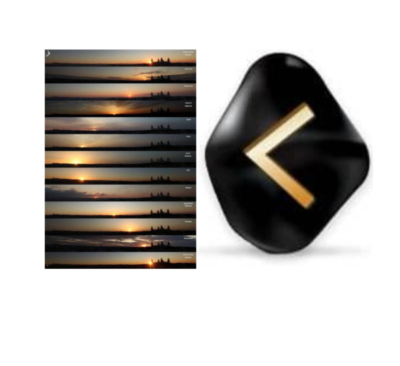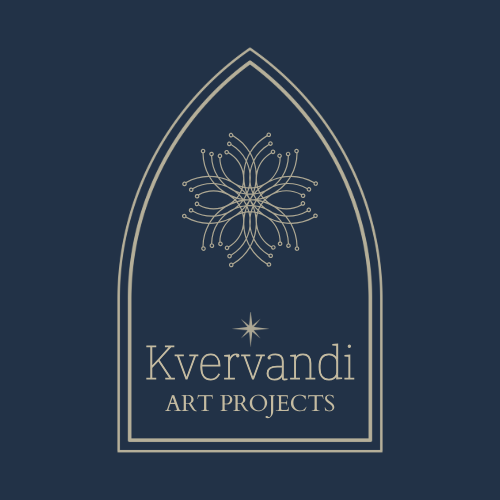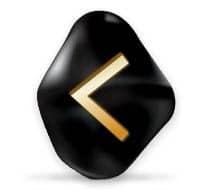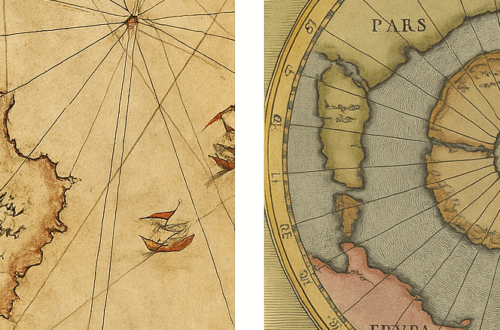
Rune & Sun: When the Sky Shapes the Runes
Astronomical Origin of Certain Runes: The Case of Kaunan and Jera
by Morgann' Gyger
The winter solstice has always been a pivotal moment in the solar year, associated with renewal rites and celestial observations. On December 21, 2020, a photograph taken in Dabouq (Amman, Jordan) by Zaid M. Al-Abbadi caught my attention. It depicted a series of 12 sunrises, captured at approximately 30-day intervals over the course of a year, from the winter solstice of 2018 to that of 2019. Upon analyzing this sequence, a recurring shape emerged – one that strikingly resembled a rune from the Elder Futhark.
The Image: Observing the Phenomenon

The image illustrates the angular variation in the position of the sunrise on the horizon throughout the months. Due to the tilt of the Earth’s axis, this movement follows a cyclical curve, with maximum amplitude at the solstices and minimal at the equinoxes.
Photo by: Zaid M. Al-Abbadi – Dabouq, Amman, Jordanie
Du solstice d’hiver 2018 à celui de 2019
What immediately caught my eye was that the path traced by these 12 successive sunrises eerily resembled the sixth rune of the Futhark: « Kaunan » (or Kenaz).
Kaunan : Symbolism and Formal Correspondences
In the Elder Futhark, Kaunan is the sixth rune. It is generally interpreted as a symbol of controlled fire (torch), enlightening knowledge, or even creative intuition. Its shape, an open chevron, suggests a directional dynamic, oriented towards a source.
The graphic similarity between the annual trajectory of the sunrise (according to the studied image) and this rune raises a hypothesis: the proto-Germanic peoples might have drawn inspiration from regular astronomical phenomena in the development of certain Futhark glyphs. This possibility warrants further exploration, in dialogue with research in archaeoastronomy.
Jera, the twelfth rune of the Futhark, is traditionally associated with the annual cycle (Jahr in German, year in English). It is represented by two curved or angular lines following each other symmetrically without touching, forming a dynamic rotational structure. This symbol, linked to agricultural cycles and seasonal fertility, seems to anchor itself in an astronomical reading of time.
Once again, the overlay between celestial movements and the shape of the glyph suggests an interpretative avenue: Jera could be a symbolic transcription of the entire solar annual cycle, with its 12 monthly phases represented by this double figure.
A Path for Study?
This intuitive observation, born from the intersection of astronomical photography and symbolic study of the runes, opens several avenues for reflection. It invites us to question the role of sky observation in the genesis of proto-historical alphabets, beyond their mere phonetic or magical function. The relationship between natural cycles (notably solar) and the development of ancient symbolic systems, including runic ones, deserves rigorous examination, intersecting:
- Symbolic anthropology (e.g., Mircea Eliade, Georges Dumézil),
- Archaeoastronomy (e.g., E.C. Krupp, Alexander Thom),
- Germanic philology and historical linguistics (e.g., R. Simek, E.O.G. Turville-Petre).
Conclusion
The correspondence between the annual solar variation and certain runic forms, notably Kaunan and Jera, may not be coincidental. If confirmed by further research, it would enhance our understanding of the runes as a symbolic system that integrates a sensitive and codified observation of the cosmos.








